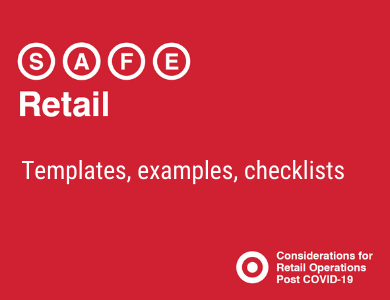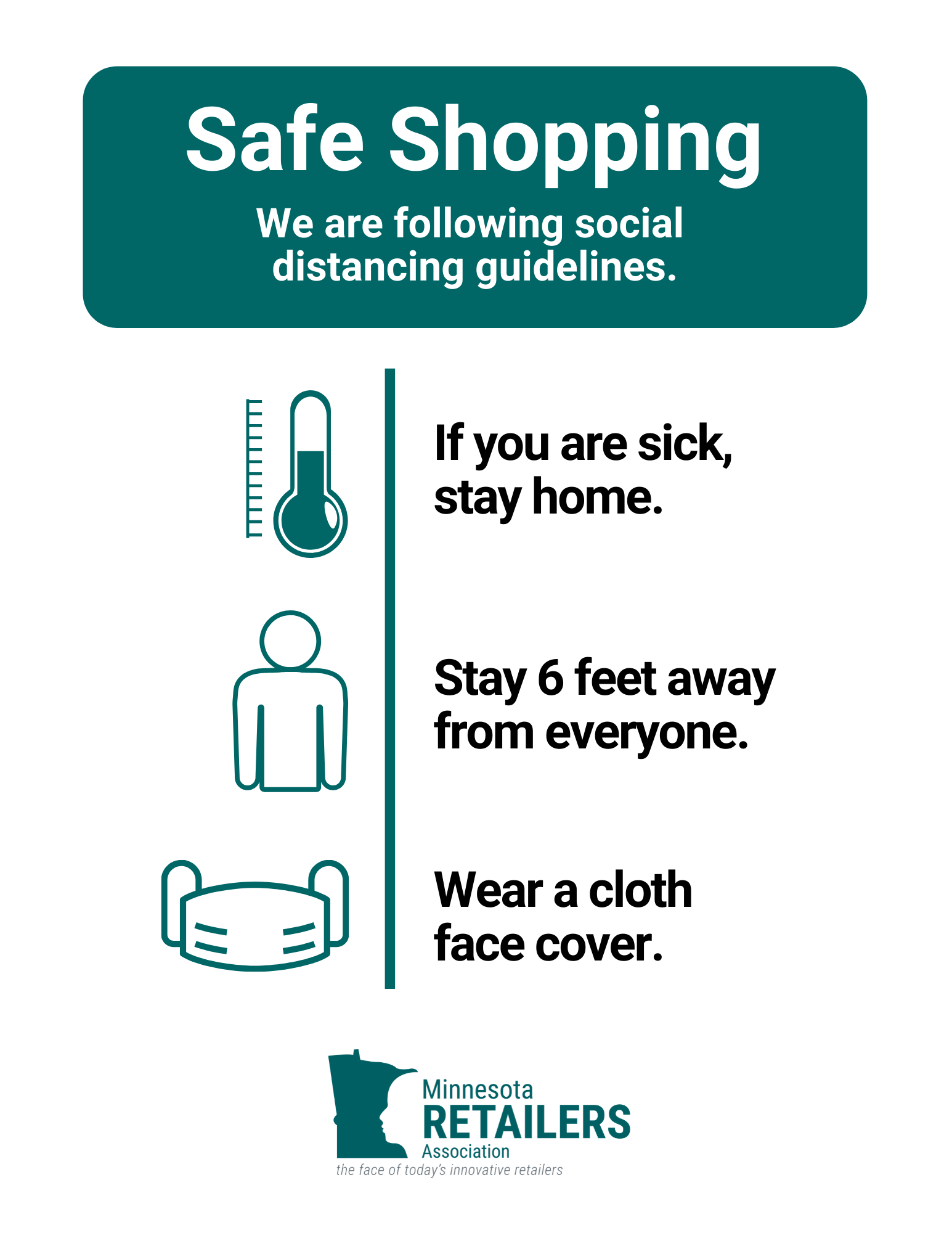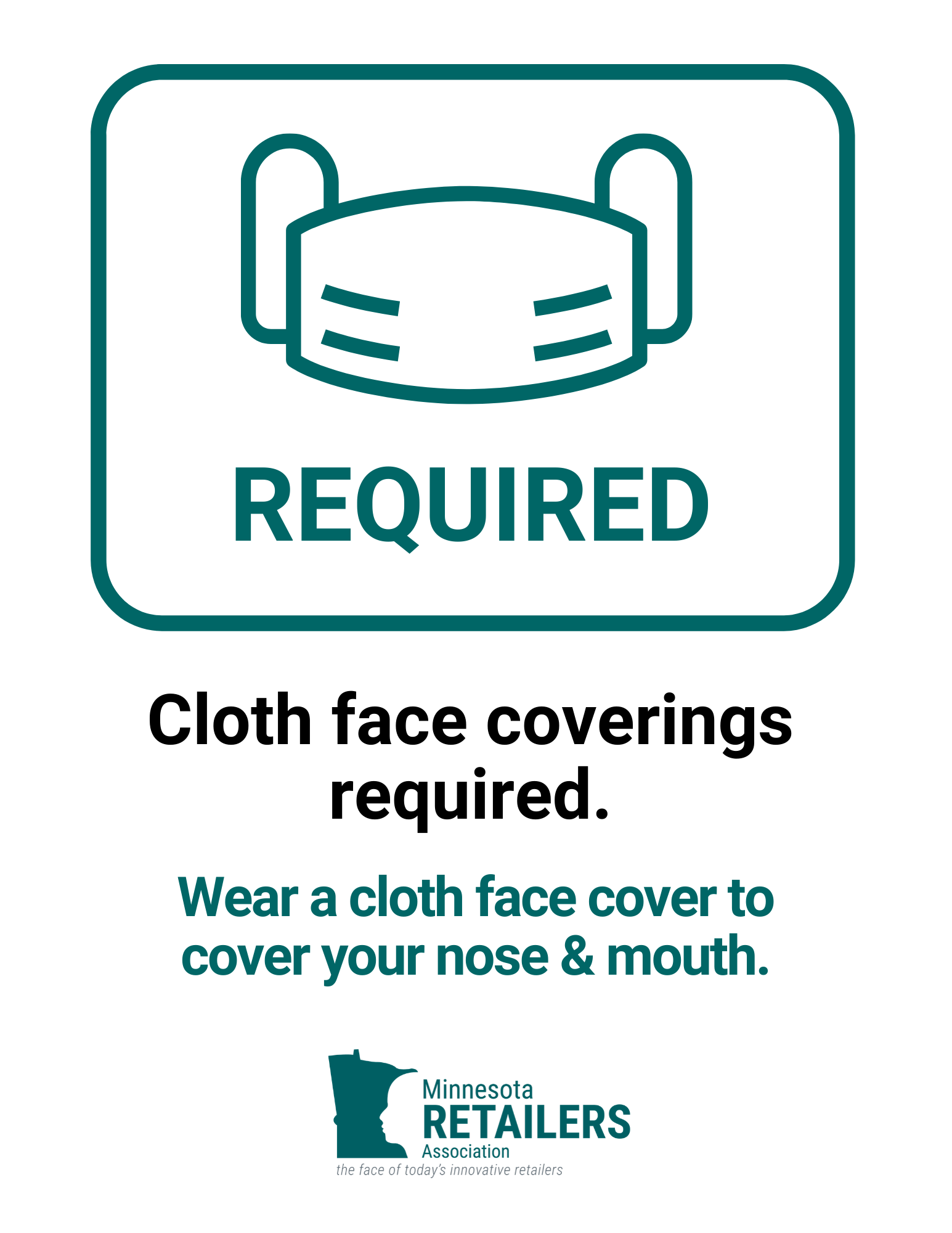Guidelines For Retailers Re-Opening

In good news for consumers and retailers, retail stores including stores and malls/shopping centers can re-open to guests on May 18 following Governor Walz issuance of Executive Order 20-56 May 13. The Minnesota Retailers Association worked with DEED Commissioner Steve Grove and a retail roundtable workgroup (representing retailers, chambers of commerce, associations, and other stakeholders) including the Minnesota Retailers Associaiton, the MetroNorth Chamber of Commerce, the Twin Cities North Chamber of Commerce and others on re-open guidelines over the past few weeks. Those guidelines are listed below.
The guidelines below do not constitute legal advice and each retailer should do its very best to put in place a re-open plan tailored to best practices and safety for employees and customers.
These guidelines are not intended to apply to restaurants, bars, salons and other business where separate re-opening plans are being contemplated or businesses that are open under existing Executive Orders. We will post links to guidelines for these business when they are available.
Dates for opening and related guidelines:
- Retail: May 18, 2020. Click here for industry guidelines from the State of Minnesota.
- Malls and Shopping Centers: May 18, 2020. Click here for industry guidelines from the State of Minnesota.
- Hair Care, Barbers, Salons: June 1. Click here for industry guidelines from the State of Minnesota.
- Restaurants and Bars: June 1. Click here for industry guidelines from the State of Minnesota.
- Gyms, Movie Theaters, Bowling Alleys: June 19, 2020. Click here for industry guidelines.
MnRA's Suggested Guidelines For Re-Opening A Minnesota Customer Facing Business
1. Requirements To Re-Open
The below items are requirements to re-open:
-
Create And Execute A Safety Plan. Retailers must have a safety plan available to workers, customers, the public and government officials with option to modify the existing COVID-19 Preparedness Plan template available at www.dli.mn.gov/updates. THIS IS REQUIRED UNDER EXECUTIVE ORDER 20-56 & SUBSEQUENT ORDERS.
-
Include Best Practices Modified To The Retail Setting. A safety plan should contemplate but need not be limited to tailored, site-specific best practices surrounding health/wellness, social distancing, cleaning/sanitation/protection, and operations/communications for in-store customers, appointments, curbside pickup and delivery. See the best practices outline and resources below for suggestions. ADDRESSING BEST PRACTICES IS REQUIRED UNDER EXECUTIVE ORDER 20-56 & SUBSEQUENT EXECUTIVE ORDERS.
Also, note the "Employer plan requirements checklist" from the Department of Labor and Industry. See this list for plan requirements which includes items for malls and shopping centers. -
Modify Occupancy To Accommodate Social Distancing. Retailers must adjust allowable occupancy and consider regulating customer flow to accommodate social distancing and safety. A 50% OCCUPANCY (MAXIMUM) STANDARD IS REQUIRED UNDER EXECUTIVE ORDER 20-56 AND SUBSEQUENT EXECUTIVE ORDERS.
2. Best Practices Outline
The below items should be considered in the safety plan and included, excluded, or modified to improve safety for employees and customers. The safety plan should be specific to the store.
Health and wellness:
-
-
Evaluate employee health according to CDC and MDH guidelines and screen employees so that only well employees are at work.
-
Adjust policies to accommodate employees not working due to illness or COVID-19 symptoms.
-
Ask that only healthy customers feeling well shop in the store.
-
Social distancing:
-
-
Evaluate space, change configuration, adjust flow and modify occupancy with guidepost of 50 percent of occupancy rating or other occupancy metric with deference to ensuring social distancing per CDC guidelines and recommendations.
-
Control building access and regulate customer movement with consideration of one-way traffic.
-
Use signage at the door and throughout the store as well as public address system messages if available to remind customers of social distancing.
-
At checkout and areas of high congestion mark out social distancing, including floor markers for distance, line lanes, and marking adjacent areas where customers may be waiting for store access.
-
At checkout extend space between the customer and clerk with markings, physical barrier, or plexiglass divider.
-
Reconfigure space used for fittings to provide social distancing between customers and protections for customers and employees.
-
Encourage customer use of curbside, delivery, and appointment options.
-
Cleaning, sanitation & protection:
-
-
Execute an enhanced, thorough overall store cleaning schedule.
-
Clean and disinfect high touch surfaces frequently.
-
Make hand sanitizer available to customers and employees.
-
Follow Minnesota Department of Heath guidance and relevant Executive Orders on face covering use by employees and customers unless a stronger store policy is articulated.
-
Add protective shields at checkout where social distancing is not practical.
-
Clean fitting rooms, especially high touch areas, following each customer use.
-
Modify merchandise return policies to accommodate cleaning and/or delay of product return to shelves.
-
Make gloves available to workers and articulate when gloves should be used.
-
Operations & communications:
-
-
Clearly communicate safety actions and procedures to employees and consumers (website, signage, e-mail).
-
Train all employees on procedures and service surrounding safety protocols and practices, including customer service reminders on social distancing.
-
Make interactions between customers and employees as contactless as practical, including fittings, signatures, transactions, and payments.
-
Have employees make a special effort to engage customers to help them find products efficiently and remind them to practice social distancing.
-
Ask a customer’s permission to touch their products, allow a customer to position their own products for checkout, and encourage self-service bagging.
-
Consider special shopping hours for high-risk individuals and modified hours of operation to accommodate cleaning.
-
Modify and communicate changes to your policies including return merchandise and reusable bags.
-
Discontinue group customer events and sampling.
-
Review safety procedures and expectations with vendors.
-
Thank customers and workers for their focus on safety.
-
3. Best Practices Resources
The following resources are available as customer facing businesses craft their plans for re-opening. If you have a best practice document or resource to share, please e-mail us at This email address is being protected from spambots. You need JavaScript enabled to view it.. As always, check www.mnretail.org/covid-19 for the latest news impacting retailers.- Governor Walz's Exectutive Order 20-56 re-opening retailers (pages 6-7)
- CDC 1) Businesses and Workplaces: Plan, Prepare, and Respond resources and 2) Interim Guidance For Businesses and Employers.
- OSHA Guidelines For Preparing Workplaces For COVID-19
- Minnesota Department of Health Guidance To Businesses And Employers.
- Minnesota Department of Labor and Industry COVID-19 updates relating to employers and workers, including a COVID-19 Preparedness Plan template.and "Employer plan requirements checklist".
- Minnesota Department of Employment & Economic Development Safely Returning To Work resources.
- Minnesota Retailers Association's 1) Best Practices For In-Store & Appointments and 2) Best Practices For Curbside & Delivery.
- Minnesota Chamber of Commerce suggested best practices.
- National Retail Federation's Operation Open Doors including checklists.
- Retail Industry Leaders Association's Blueprint For Safe Shopping including recommended protocols.
- Target's S.A.F.E. Retail lessons learned and shared, including examples, templates and checklists.
- Walmart's 1) Shop Smart and Stay Healthy guidance and 2) response to COVID-19 webpage.

Download & Print Signs
Based on requests from retailers, MnRA offers these signs for download and print. Note: Face coverings are strongly recommended by the Governor and each retailer is allowed to make its own decision on whether they are required or requested. As such we are providing two sign options below.
 |
 |
 |
|||
| Safe Shopping reminders PDF. | Face covered requested PDF. | Face covered required PDF. |
Also, check out the Target S.A.F.E. Retail document for many printable signs and policies.
Just Added: Watch Our Re-Opening Guidance Webinar Now
Related Articles
- Retail Responds: Clothing Stores Put Talents To Work Making Healthcare Worker Masks
- Store Best Practices For Social Distancing: In-Store & Appointment
- Critical Next Steps For Minnesota’s Retailers & Consumers
- Store Best Practices For Social Distancing: Curbside & Delivery
About the Author
Bruce Nustad
Bruce Nustad is president of the Minnesota Retailers Association.
